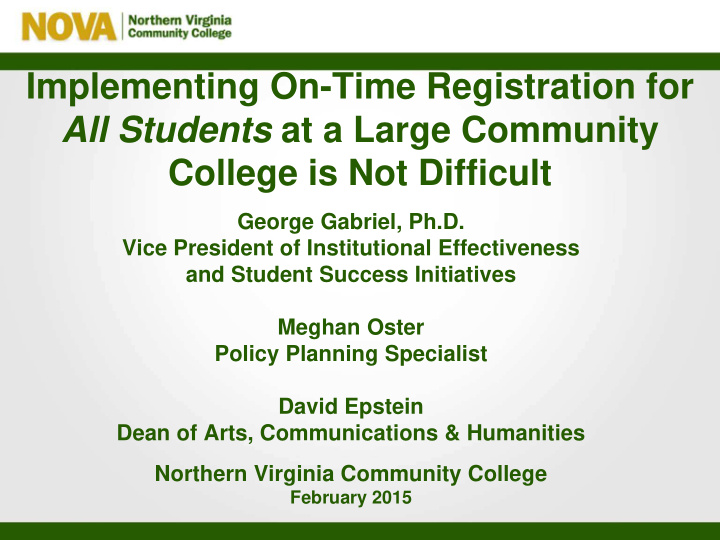



Implementing On-Time Registration for All Students at a Large Community College is Not Difficult George Gabriel, Ph.D. Vice President of Institutional Effectiveness and Student Success Initiatives Meghan Oster Policy Planning Specialist David Epstein Dean of Arts, Communications & Humanities Northern Virginia Community College February 2015
Presentation Outline NOVA Background Why On-Time Registration for All Students Implementing On-Time Registration Lessons Learned 2
NOVA Student Characteristics Over 150 Countries 78,461 Students Represented (Annual Headcount) 150 Degrees and 4,260 Faculty & Staff Certificates Offered 24,300 Enrolled in 6 Campuses Workforce Development 3 Centers 25,342 Enrolled in Outside of Extended Learning Institute Washington, D.C . (Annual Headcount) 3
Why On-Time Registration for All Students On-Time Registration Overall, on-time registration has proven to increase student success (NOVA Data) Minimizes disruption by late registrants Instructors do not need to go over material already covered Instruction on learning skills, class protocols, semester calendar can be covered in first class All students begin from the same starting point 4
How Many Students Would Mandatory On-time Registration Impact? 5
Figure 1. Number of NOVA Students Who Registered On-Time for All Courses and Students Who Registered Late for At Least One Course: Fall 2009 through Fall 2013 Cohorts Registered for All Classes On-Time Registered Late for At Least One Class 11,288 11,372 11,023 11,067 10,948 # OF STUDENTS 40,576 40,431 39,021 37,929 35,671 FALL 2009 FALL 2010 FALL 2011 FALL 2012 FALL 2013 COHORT 6
Figure 2. Percentage of NOVA Students Who Registered On-Time for All Courses and Students Who Registered Late for At Least One Course: Fall 2009 through Fall 2013 Cohorts 100.0% Registered for All Classes On-Time Registered Late for At Least One Class 78.2 78.1 78.0 77.4 76.5 80.0% % of Students 60.0% 40.0% 23.5 22.6 22.0 22.0 21.8 20.0% 0.0% Fall 2009 Fall 2010 Fall 2011 Fall 2012 Fall 2013 7
Implementing On-Time Registration for All Students 8
PCI Composition Representatives from all relevant stakeholder groups • IR/IT/Marketing Staff • Business Managers/Financial Aid Staff • Academic Deans • Registrars Different levels of administrators • Provosts/VPs • Deans • Assistant Deans • Directors • Faculty/Staff 9
Composition Resulted in Wide Input Encouraged extensive dialogue • Meaningful conversations and interactions • Received timely and relevant feedback from front-line staff Effective and efficient implementation • Detailed planning • Limited disruption of services • Wide support for policy changes 10
Several Components for Implementation IT Support Exemption Class Approval Scheduling Process Special Marketing Groups On-Time Role of IR Documents Registration 11
Role of IR (Use of Data) Using trend data, IR built possible scenarios Provided target data to frontline staff (New Student Orientation) Tracked registration during summer Used the Call Center to gather student feedback during the summer 12
Critical Nature of Communication to Faculty and Staff Faculty • Clearly inform them how to implement the policy in their classroom (e.g., checking rosters during the first week) Staff • Must be policy experts and advise students accurately • Variety of departments had to know the policy: • Business Office • Financial Aid • Advising • Academic Departments 13
Repeated Communication to Students Students • Used a variety of modes to communicate the policy: • Email • Digital signage • Facebook/Twitter • Posters/Signs 14
Importance of Appropriate Class Scheduling Data Analysis • Investigated high enrollment courses by campus to ensure enough courses were offered to meet demand Session Utilization • Provided varying start dates so individuals can comply with the mandate, start courses at different times during the semester (12-week, 8-week, online, etc.) • Used online courses effectively 15
Extensive IT Support IT Issues/Considerations: Policy implementation had to be done within IT capabilities Limiting Loopholes: Denying possibilities of students finding ways to circumvent new policies 16
Exemption Approval Process Forms: Waivers/Exceptions were controlled at the Deans level through forms (uniformity). Procedures: Written guidance to frontline staff and decision makers on how to deal with issues during implementation (consistency). 17
Accommodating Special Groups Senior Citizens • Because of a specific policy for senior citizens, NOVA had to find a way to work around the system for this specific group 18
Extensive Documentation in Advance Compiled all documents/decisions made during the planning process into a single document (user guide). Certain documents, decisions, and guidance were shared with only faculty and staff in order to prevent students from circumventing the new policies. 19
On-Time Registration Preliminary Results 20
Student Survey: Findings On-Time Registration 50% 95% indicated that 37% enrolled indicated that the enrolled 58% agreed in a class in they were at least 2 with the an alternate aware of the weeks earlier policy session policy than previous semesters 21
Faculty/Staff Survey: Findings On-Time Registration 89% indicated 34% reported 97% indicated 79% agreed that the policy reenrolling a that they were that the policy had been student who aware of the would benefit clearly had dropped a policy students communicated course 22
Implementation: Key Metrics Figure 1. Late Course Registration by Session: Fall 2013 and Fall 2014 (with permission) Fall 2013 Fall 2014 19% 20% 15% Percent 11% 10% 10% 9% 8% 5% 3% 2% 2% 0% 16-week 1st 8-week 2nd 8-week Dynamic Session 23
Lessons Learned 24
Lessons Learned: Communication Student communication is very critical. Begin the campaign early and find multiple channels. Front-line staff, faculty, and administrators are brought into the loop very early. 25
Lessons Learned: Use of Data Provide data from past years, set up targets, and track the progress and implementation continues. Involve IT staff heavily in the process so that they can make necessary adjustments in real- time. 26
Lessons Learned: Composition of the Committee Assemble a cross-functional group. Assemble a group that consists of people from the top to the bottom of the hierarchy. 27
Lessons Learned: Rally the College Community Use logos, taglines, and other visual aids to impress the students and other stake holders. Get the college president to repeatedly communicate to the College community. 28
Questions? 29
Recommend
More recommend